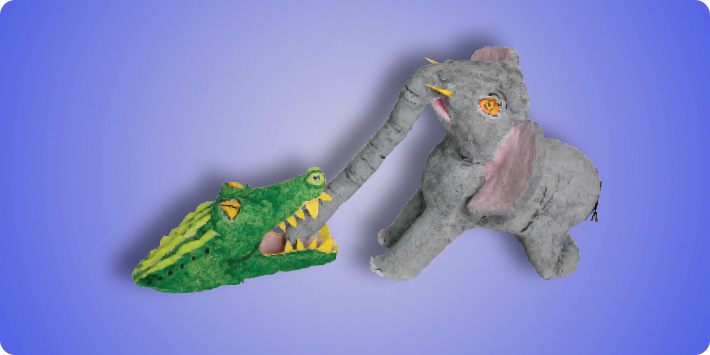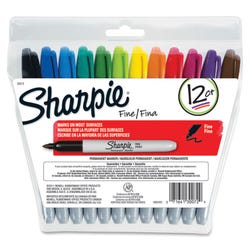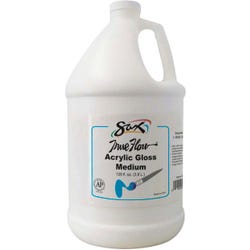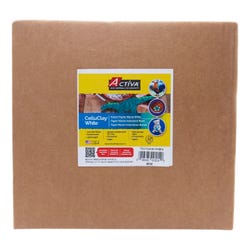Container Creatures

Description
The example for this lesson was created in response to one of Rudyard Kiplings Just So Stories. These classic stories explain in amusing fantasy fables such puzzles as How the leopard got its spots and How the elephant got its trunk. Though written more than 100 years ago, and reflecting some of the attitudes of that time period, the stories are told in a style that is sure to bring laughter and will inspire your students to create their own funny creatures from the stories. This lesson introduces the use of recycled containers as armatures for sculptures. Celluclay® Instant Papier-Mache is applied to the armature to create a hard and durable finished product.
Objectives
- Students will learn the process of building an armature for a sculpture of an animal.
- Students will select a story that is amusing to them and create a creature from that tale.
Supplies Needed
School Smart® Masking Tape, 1 x 60-Yd. Roll, Pack of 6 1354274
Celluclay® Instant Papier-Mache, White, 25 lbs. 350078
Acrylics, 12-Pint Set 439304
Utility Knife (with adult supervision)No. 24 Med. Duty 401111
School Smart® Large Rolling Pin 085817
Latex Gloves, Kid Size, Box of 100 245885
Sax® True Flow® Acrylic Gloss Medium, Gallon 247313
Sax® True Flow® Tempera Varnish, Gloss, Gallon 402270
Sharpie® Markers, 12-Color Set, Fine Tip 067115
Armature Wire 14 gauge, 350-Ft. Roll 405627
Pencil and scratch paper
Recycled plastic and cardboard containers, tubes, newspaper, etc.
Scissors
Containers for Mixing Celluclay® Instant Papier-Mache
Brushes
Things You May Also Need:
Ziploc Plastic Bags (for mixing Ultra Mache and storing unfinished projects)
Photos of animals from books, magazines and the Internet
Craft Items such as Wiggle Eyes, Foam Shapes, etc.
Plastic Food Wrap
Glue
Resources
Just So Stories, by Rudyard Kipling. Available in libraries and bookstores
Standards
CONTENT Standard #1: Understanding and applying media, techniques and processes.
Grades K-4: Students will use different media, techniques and processes to communicate ideas, experiences and stories.
Grade 5-7: Students will intentionally take advantage of the qualities and characteristics of art media, techniques and processes to enhance communication of their experiences and ideas.
Instructions
1
Read a selection of Rudyard Kiplings Just So Stories or other childrens literature about animals to your students.
2
Draw sketches from the story using photos for reference. Try to use exaggeration of movement and expression to help tell the story.
3
Choose the best sketch and go through collected recyclables for things that might be used for bodies, heads, legs, wings or whatever is needed to make your animal. You may wind up using only part of a bottle or other container. Even if something is not exactly the right shape, it may be modified by taping on crumpled newspaper.
4
Begin to tape all the parts together with masking tape. Taping securely is important!
5
Where shapes need modification, cut away parts or tape on crumpled newspaper. Armature wire twisted or coiled can be used for body parts that you cannot find recycled objects for.
6
Once the armature is built, mix up the Mache according to directions. You and your students may wish to wear latex gloves when working with the Mache. The manufacturers suggestion to put the mix and the water in a large Ziploc bag and then knead it until thoroughly mixed is a good one.
7
Cover the armature with the mixed Mache. An easy method for adding a layer of the Mache is to roll out slabs of it between two large pieces of plastic wrap. Then use pieces of the slabs to wrap around the body, legs, neck, etc.
8
While working on the Ultra Mache, keep a bowl of water handy and constantly smooth the surface with wet fingers. Though Ultra Mache can be sanded or filed when dry, it is much easier to make changes while it is wet.
9
Model any details such as folds of skin, large eyeballs, or nostrils out of the Mache and press into place.
10
Store the unfinished animal in a closed plastic bag between classes.
11
When animal is covered with Mache and all of the forms are as desired, let dry. Turn the animal occasionally so that it can dry on all sides. Allow several days for drying.
12
When dry, the animal can be painted with acrylics or other paints and decorated with markers and craft items. (The teeth of the alligator in the example are heavy cardboard glued to the mouth.) It may be sealed with an acrylic varnish or Multimedia Varnish.





